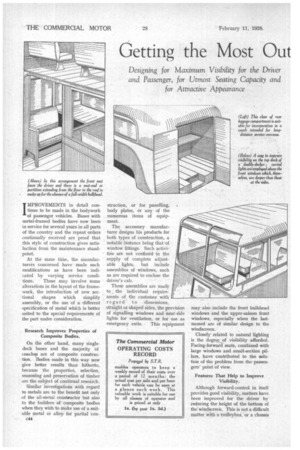Getting the Most Out of the Coach and Bus Body
Page 94

Page 95

If you've noticed an error in this article please click here to report it so we can fix it.
Designing for Maximum Visibility for the Driver and Passenger, for Utmost Seating Capacity and for Attractive Appearance
MPROVEMENTS in detail con tinue to be made in the bodywork of passenger vehicles. Buses with metal-framed bodies have now been in service for several years in all parts of the country and the repeat orders continually received are proof that this style of construction gives satisfaction from the maintenance standpoint.
At the same tithe, the manufacturers concerned have made such modifications as have been indicated by varying service condi tions. These may involve some alterations in the layout of the framework, the introduction of new sectional shapes which simplify assembly, or the use of a different specification of metal which is better suited to the special requirements of the part under consideration.
Research Improves Properties of Composite Bodies.
On the other hand, many singledeck buses and the majority of coachtp are of composite construction. Bodies made in this way now give better results than hitherto, because the properties, selection, seasoning and preservation of timber are the subject of continual research.
Similar investigations with regard to metals are to the benefit not only of the all-metal constructor but also to the builders of composite bodies when they wish to make use of a suitable metal or alloy, for partial con
c44 struction, or for panelling, body plates, or any of the numerous items of equipment.
The accessory manufacturer designs his products for both types of construction, a notable instance being that'of window fittings. Such activities are not confined to the
• supply of complete adjustable lights, but include assemblies of windows, such as are required to enclose the driver's cab.
These assemblies are made to the individual requirements of the customer with regard to 'dimensions, straight or shaped sides, the provision of signalling windows and near-side lights for ventilation, or for use as emergency exits.. This equipment may also include the front bulkhead windows and the upper-saloon front windows, especially when the lastnamed are of similar design to the windscreen.
Closely related to natural lighting is the degree of visibility afforded. Facing-forward seats, combined with large windows and small-section pillars, have• contributed to the solution of the problem from the passengers' point of view.
Features That Help to Improve Visibility.
Although forward-control in itself provides good visibility, matters have been improved for the driver by reducing the height of the bottom of the windscreen. This is not a difficult matter with a.trolleYbui, or a chassis with an engine mounted otherwise than in front. In other instances the height of the radiator casing can be modified if, by so doing, visibility for the driver be materially improved.
Another aid to visibility is the curved roof window immediately above the cant-rail. A few coaches with these windows have been in use in this country for a-year or two, but on the Continent they are rapidly increasing in favour and examples were on view at both the recent Brussels and Amsterdam exhibitions.
These windows could also be utilized for the upper saloon of the double-decker, with the advantage that similar lights could be inserted above the front windows.
The chassis for passenger bodywork is designed to provide the maximum space for seating in relation to the overall length of the vehicle. Present-day conceptions of comfort demand adequate knee and leg room, consequently any new arrangement of the power unit, or in the disposition of the axles, particularly the front one, which tends to increase the amount of seating space available is closely scrutinized in order to see whether an extra seat may be added, even if it has to be lengthwise.
How the Extra Seat May be Arranged.
Such a seat may be fitted on the near side in front and facing the driver. Fromlhe constructional point of view, the continuous front bulkhead has to be omitted, but the loss of this cross-tie may, to a certain extent, be compensated by introducing a framed end to the seat, which extends from floor to roof and is designed so that access to the seat is not impeded. This partition-end must, however, be set out so that it




























































































































































